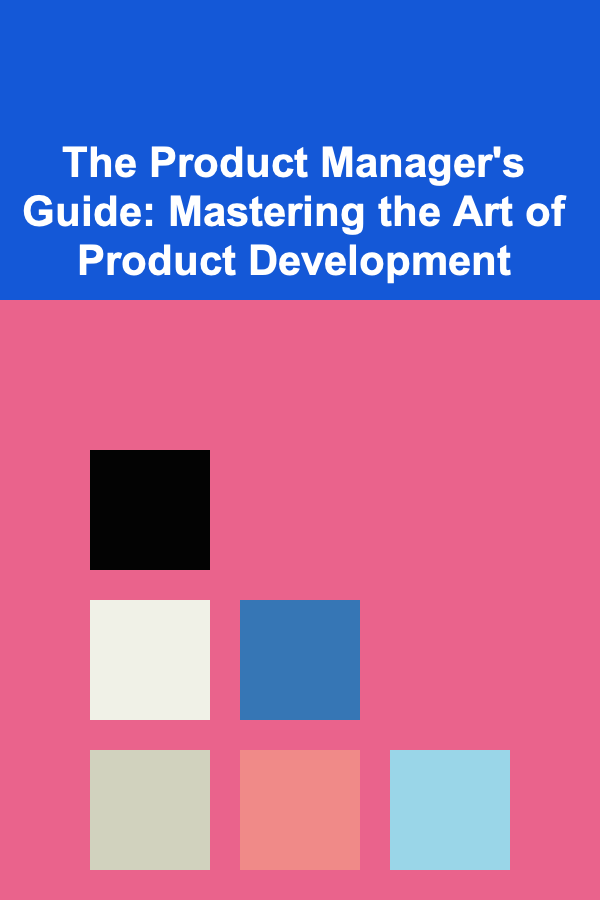
The Product Manager's Guide: Mastering the Art of Product Development
ebook include PDF & Audio bundle (Micro Guide)
$12.99$6.99
Limited Time Offer! Order within the next:

Product development is the lifeblood of any company that aims to create products that resonate with customers. At the heart of this process is the Product Manager (PM), whose job is to ensure the product meets market needs, aligns with business goals, and delivers value to both the company and the end-user. However, product development is not a linear path; it's a complex, ever-evolving journey that demands a combination of strategic thinking, technical knowledge, and customer empathy.
This guide aims to provide actionable steps for aspiring and experienced Product Managers to not only understand the intricacies of product development but to also excel in the role. Through this, we'll explore the key elements that contribute to a successful product development process and provide a roadmap for mastering the art of product management.
Understanding the Product Management Role
Before diving into product development, it's crucial to understand what a Product Manager is responsible for. The PM acts as the bridge between various departments: engineering, marketing, design, sales, and customer support. They need to maintain a delicate balance between aligning stakeholders' expectations and ensuring the product vision stays intact. The primary role is to make decisions that will shape the product's development, prioritize features, and ultimately, ensure the product succeeds in the market.
1.1 Key Responsibilities of a Product Manager
- Vision and Strategy: A PM defines the product vision and ensures that all teams are aligned with this vision.
- Roadmap Creation: Developing and maintaining a product roadmap that outlines when key features and milestones should be delivered.
- Stakeholder Communication: Act as the point of contact for all departments, ensuring that everyone is informed of changes and progress.
- Customer Focus: Continuously gathering customer feedback, identifying pain points, and ensuring the product solves real user problems.
- Prioritization: Making tough decisions on what to build next, based on available resources and potential impact.
- Execution and Delivery: Overseeing the execution of the product plan, ensuring that timelines are met and quality is maintained.
Laying the Foundation: Product Discovery
The foundation of any successful product starts with discovery. This is the phase where you identify customer pain points, evaluate market opportunities, and validate assumptions before developing anything.
2.1 Understanding Market and Customer Needs
One of the primary goals of a PM is to create a product that solves a real customer problem. To do this effectively, thorough customer and market research is necessary.
Actionable Steps:
- Customer Interviews: Speak directly with current or potential customers to understand their problems, needs, and desires. Create open-ended questions that allow customers to share deep insights.
- Surveys and Feedback Loops: Use surveys to quantify customer pain points and preferences. Build a feedback loop so that customers can continually inform product improvements.
- Competitor Analysis: Conduct a thorough analysis of your competitors' products. What are their strengths? What gaps exist in the market that your product can fill?
2.2 Defining the Problem
Once you have gathered insights, it's essential to synthesize this information to clearly define the problem you aim to solve. This is where product-market fit begins. A well-defined problem statement will guide the product's direction.
Actionable Steps:
- Persona Development: Create detailed buyer personas based on customer data. These personas should include demographics, goals, challenges, and behavioral patterns.
- Problem Framing: Craft problem statements that articulate the customer pain points clearly and focus on the "why" behind the product need.
- Opportunity Assessment: Quantify the potential impact of solving the identified problem. Is this a high-value opportunity that aligns with your company's strategic goals?
Building the Product Roadmap
After the discovery phase, it's time to start creating the product roadmap. A roadmap serves as a blueprint for the product's development and ensures that the team stays on track toward the vision.
3.1 Prioritization Frameworks
The roadmap needs to be created with clear priorities in mind. The art of product management lies in making the right choices about what to build next, balancing customer needs, business goals, and technical feasibility.
Actionable Steps:
- MoSCoW Method: Classify features into Must-have, Should-have, Could-have, and Won't-have categories. This helps you focus on the most critical features while not neglecting minor but valuable additions.
- RICE Scoring: Evaluate features based on Reach, Impact, Confidence, and Effort. This quantitative approach helps PMs assess which initiatives will create the most value with the least amount of effort.
- Kano Model: Use the Kano model to understand which features will delight customers, which are basic expectations, and which will result in dissatisfaction if they're not included.
3.2 Creating the Roadmap
A product roadmap should be both strategic and tactical. It outlines the vision for the product while breaking down key milestones and deliverables.
Actionable Steps:
- Set Clear Milestones: Identify key phases in the product lifecycle such as MVP (Minimum Viable Product), beta testing, and launch.
- Balance Short and Long-Term Goals: Create a mix of quick wins that drive immediate value and long-term initiatives that contribute to the overarching product vision.
- Iterate and Adapt: Your roadmap should be flexible. Continuously review and adjust based on market changes, customer feedback, and internal constraints.
Product Development: From Concept to Execution
Once the roadmap is in place, the real work begins---building the product. This phase requires collaboration across teams, from engineering to design to marketing.
4.1 Cross-Functional Collaboration
Effective communication and alignment are critical during this phase. As a PM, you'll work closely with engineers, designers, marketers, and sales teams to ensure that everyone is on the same page and working towards the same goal.
Actionable Steps:
- Daily Standups: Ensure that communication channels are open. Short, focused meetings keep everyone aligned on the day-to-day tasks and any blockers that need to be addressed.
- Design and Development Sprints: Use agile methodologies to break down development into manageable chunks, allowing for regular feedback and adjustments.
- Clear Specifications: Work with designers and engineers to ensure that product specifications are clear and that everyone understands the "why" behind each feature.
4.2 Balancing Speed and Quality
While it's important to move quickly and meet deadlines, quality should never be compromised. Speed should always be balanced with thorough testing and quality assurance processes.
Actionable Steps:
- Test Early, Test Often: Introduce testing and feedback loops as early as possible. Use prototypes and beta releases to gather user input before the final product is launched.
- Continuous Integration and Deployment: Implement a continuous integration (CI) system where small changes are tested frequently and integrated into the codebase, reducing bugs and improving efficiency.
- Quality Metrics: Track product quality using metrics such as defect density, user satisfaction, and performance testing. Use this data to make informed decisions about the product.
Launch and Post-Launch Activities
The launch phase is just the beginning. The real challenge starts after the product hits the market, where tracking user behavior, gathering feedback, and iterating on the product are paramount.
5.1 Tracking Success Metrics
To understand whether the product is meeting its objectives, it's essential to define key performance indicators (KPIs) that align with your business goals.
Actionable Steps:
- User Engagement: Track metrics such as active users, session length, and user retention to measure how engaged customers are with the product.
- Conversion Rates: Monitor conversion rates across various stages of the user journey---this could include free-to-paid conversions, onboarding success rates, etc.
- Customer Feedback: Keep an open channel for customer feedback, using surveys, reviews, and support tickets to understand how users perceive the product.
5.2 Continuous Iteration
No product is perfect at launch. Post-launch activities involve collecting data, responding to customer needs, and iterating on the product to address issues or improve functionality.
Actionable Steps:
- Monitor User Behavior: Use tools like heatmaps, user session recordings, and A/B testing to observe how users interact with the product.
- Fix Bugs and Address Pain Points: Quickly address critical bugs that affect user experience, and prioritize new features that can enhance customer satisfaction.
- Iterative Updates: Release product updates regularly, adding enhancements or new features based on user feedback and market demand.
Conclusion
Mastering the art of product development is a dynamic and ongoing process. Product Managers must wear many hats: visionary, strategist, communicator, and executor. By understanding the entire lifecycle of product development---from discovery through to post-launch---you'll be better equipped to lead teams, deliver impactful products, and drive meaningful outcomes for the company.
The path to becoming a successful PM is paved with challenges, but with the right tools, frameworks, and mindset, you'll be able to create products that not only meet but exceed customer expectations.

Beginner Guide: How to Learn a New Language
Read More
How to Incorporate Vintage Charm in Your Home Renovation
Read More
How to Make Money Online as a Physician Assistant: 10 Actionable Ideas
Read More
How to Make Your Home Party More Sustainable and Eco-Friendly
Read More
How to Plan for Major Home Renovations and Maintenance Needs
Read More
How to Store Kitchen Gadgets in a Small Drawer
Read MoreOther Products

Beginner Guide: How to Learn a New Language
Read More
How to Incorporate Vintage Charm in Your Home Renovation
Read More
How to Make Money Online as a Physician Assistant: 10 Actionable Ideas
Read More
How to Make Your Home Party More Sustainable and Eco-Friendly
Read More
How to Plan for Major Home Renovations and Maintenance Needs
Read More